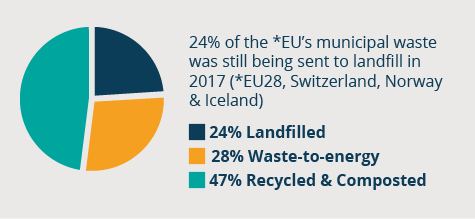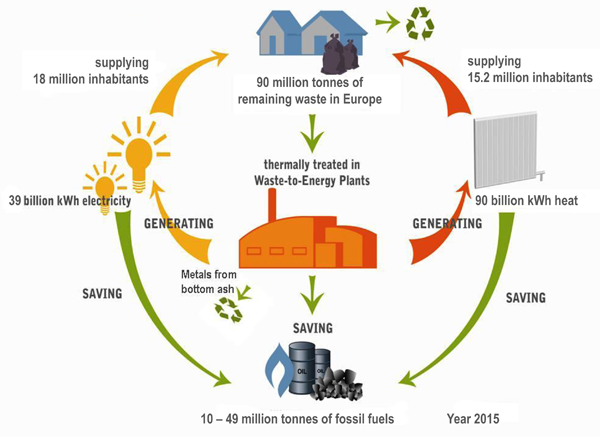Key Facts
Introduction

Municipal waste treatment in 2017 in EU28. Source: CEWEP
- Waste-to-Energy (WtE) plants are in operation right across the EU and interest in CCUS is growing as landfill sites are phased out.
- WtE is complementary to other waste treatment methods, like recycling, as part of an integrated waste management system.
- WtE diverts waste from landfill, reducing environmental impacts such as groundwater pollution and methane emissions.
WtE in Daily Life

Source: CEWEP
- WtE gives you seven 5-minute showers from just 10kg of residual waste.
- WtE gives you three hours per day of laptop charging time for 2 whole months from just 10kg of residual waste.
- WtE gives you 8 hours of heat to warm your home from just 10kg of residual waste.
WtE Cycle

Source: CEWEP
- WtE is a hygienic method of waste treatment, reducing the overall volume of waste by 90% and removing pollutants from circulation.
- WtE plants generate energy that can be fed into the electricity grid or be used for industrial processes and heating/cooling.
- WtE plants emit significantly less CO2 than fossil fuel power plants and can help reduce our dependency on carbon-intensive fuels.
- WtE helps to recover valuable resources such as metals and minerals, to be used in the automotive and construction industries.
- WtE plants in Europe can supply 18 million inhabitants with electricity and 15.2 million inhabitants with heat.
- WtE can contribute towards security of energy supply.
Negative Emissions from WtE with CCUS
- CCUS for WtE can provide sustainable energy that is low-carbon and cost-effective.
- CCUS for WtE contributes towards circular economy objectives by maximising the value of products and materials rather than throwing them away.
- CCUS for WtE can help to limit the most severe climate change impacts by preventing harmful emissions from reaching the atmosphere.
- CCUS for WtE can help create negative emissions and can be used without adversely affecting land use or food security.

Graphic: SCCS and Starbit
